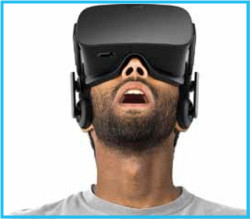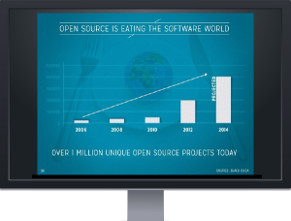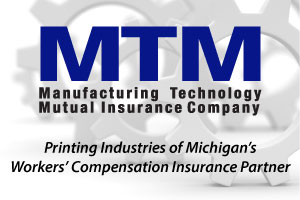
World’s Largest Post Office Does More Business
Than Post Offices in Top Five Media Markets Combined • Usps.com Sales Eclipse $1 Billion
By USPS

Customers are always at the front of the line at this Post Office that never closes. With a click of the mouse customers can conveniently ship from their homes to any location by scheduling a next-day package pickup — saving a trip to the Post Office.
During fiscal 2015 (Oct. 1, 2014-Sept. 30, 2015) usps.com generated more than $1 billion in sales — a major milestone for the 15-year-old site. The sales exceeded that of all Post Offices combined in the following media markets: New York City, Los Angeles, Chicago, Philadelphia, and Dallas.
“We’re everywhere so you can be anywhere,” said U.S. Postal Service Acting Chief Marketing and Sales Officer Jim Cochrane. “With usps.com, your Post Office is as close as your desktop or smartphone, so doing business with us is fast and convenient during this busy holiday season and all year long. Our dedicated employees are ready to serve customers with prompt service at nearly 32,000 Post Offices nationwide. We also provide convenient access at more than 70,000 grocery stores, drug stores, office supply stores, ATMs and other locations where customers can buy stamps and other postal products.”
Usps.com can provide virtually any service offered at a brick- and-mortar Post Office.
- Track Packages — My USPS is an easier way to receive updates for incoming packages with real-time delivery notifications which are available within a few minutes of the delivery scan for select packages. My USPS filters updates for all incoming packages in one central dashboard, which is accessible on mobile devices and desktop computers.
- Purchase Shipping and Mailing Supplies — Visit the Postal Store to purchase the Charlie Brown Forever stamps and other stamps, and order free shipping supplies, including boxes.
- Schedule a Free Package Pickup — Schedule a Pickup, and a carrier will get the package during regular delivery. Multiple pickups can be requested once an account is created on usps.com.
- Ship Packages — Consumers can use Click-N-Ship as a stress- free tool to pay and print postage for gifts from a mobile device or desktop computer. Sign up to start creating shipping labels and pay for the postage online.
- Hold Mail — Going away? Take advantage of the Request Hold Mail Service. All your mail is kept safely at the local Post Office until you return.
- Forward Mail — For a fee, mail can be held, packaged, and shipped weekly by Priority Mail using Premium Forward Service.
- Ship Internationally — Depending upon the type of service selected, save money off retail prices when printing a shipping label from home. Use the built-in address form to transfer information into country-specific customs forms.
- Calculate Postage — The postage price calculator provides estimates for sending packages, domestically or internationally.
Customers can do all of this — all from the comfort of their homes — by going to usps.com or downloading USPS Mobile on iOS or Android devices. These services can be accessed with the tap of a finger.
Customers can complete the steps to change an address on the USPS mobile app by simply clicking on the Change of Address icon. This convenient feature for USPS Mobile customers is in addition to others, including: USPS Tracking, My USPS, Ship Online, Buy Stamps, Find a Post Office Location, Calculate (or Look Up) Prices, ZIP Codes, Schedule a Pickup and Hold Mail.
Content-first Multichannel Publishing for the Win
By Charles Groce, CEO Pearl Street Consulting
I recall back in 2009 while working as an IT manager at a commercial printing company which handled a lot of publication work how excited we were to start offering our customers “flip-book” or “eZine” versions of their printed publications. This was, we thought, really getting into the business of internet publication. And the best part of it all was that we could obtain flip book licenses at a relatively low cost and without much additional work added on to our prepress workflow, allowing us to tack on another invoice line item. It was great! We didn’t even need a web designer!
Then came the rise of the smart phone, with some 35% of internet users today only consuming online content on their mobile devices. PDFs designed for printed publications, whether in flip book format or whether read simply using a PDF reader, didn’t provide a pleasant reading experience on mobile because of the multiple column format of most well-designed publications. Users of smart phones simply do not want to zoom in to read and zoom out to navigate. Consumers of content get a much less distracting reading experience with the mobile responsive web, which automatically formats text and graphical content as single-column while maintaining a look consistent with the full web version.
The undeniable importance of web and mobile publishing today begs the question: Is it possible for publishers and their partners in the printing industry to start with a workflow strategy which begins with content intake and produces from this process not only a fully designed printed publication, but also a mobile-responsive web site, and perhaps even email marketing content?
The answer is yes, of course. We could just add more people to the process. But money is made when processes are done efficiently, and in the world of digital information this means leveraging software intelligently to create workflow automation.
I’ve written a lot about open source solutions and how they can satisfy a whole range of operational needs for companies in the printing industry. Open source technology can also be used to vastly extend the reach of publication content, and this can benefit both printers and content creators alike.
Think about it. Many magazine publications in the abstract are really just a set of articles, each of which represent one of the many goals of the publishers. In academia, this goal may be recruitment to individual programs like nursing or film making. In business, publication content may be promotional in nature and designed to attract new customers. On behalf of institutions, content may be more informational in design.
Regardless of the end goal of content, in the internet world, each of these articles would necessarily have their own associated URL or web link, allowing users to consume ideally only the content in which they’re interested.
Article URLs can then be posted to and promoted on social media channels like Facebook. Social media channels offer unparalleled demographic targeting and tracking capabilities, two things not yet fully realized in print + direct mail, allowing content distributors the ability to deliver articles to a much more granular audience than can be offered by saturation mailing. The result is a very powerful, affordable way to target the right audience with the right content.
Email marketing offers similar benefits, with link tracking and targeting capabilities inherent in the more popular email marketing platforms. All of these require reformatting and re-purposing the original content for each platform.
You may be thinking this all sounds great but it also sounds enormously time consuming and expensive! Your graphic designer may not have the time to format all that content for the web, for email consumption, or for social media. Your graphic designer may not even know HTML!
But with technology, in business anyway, anything is possible. And the one thing you can count on is that a more efficient way of doing things will eventually arise out of the production process. Open source, community built solutions exist today which will allow the conversion of a print-centric, traditional content intake workflow into something more flexible, automated, and efficient at zero dollars in licensing costs. Such an extension of publication content (content which took a lot of work to produce in the first place!) vastly extends the reach of your publication message.
And the benefits of taking a content-first approach to publishing aren’t just limited to just publishers. Printers who offer these capabilities to their publication customers will find that their customers no longer think of their company as simply another provider of printing services. Rather by providing these value-added services, printing companies become more and more partners to publishers. More services strengthens the vendor-publisher relationship and helps ensure it will last longer. Offering these types of value-added services to publishers at low cost by utilizing technology means printing companies can actually make money doing this.
About the author: Charles Groce is the CEO of Pearl Street Consulting, a Michigan-based IT, web, and software consultancy. Charles is also the owner/operator osforprint.com, an open source technology solutions provider for the printing industry.

Where is VR going? And why you need to know.
By Kevin R. Donley, kevin@multimediaman.org
 On November 2, video game maker Activision Blizzard Entertainment announced a $5.9 billion purchase of King Digital Entertainment, maker of the mobile app game Candy Crush Saga. Activision Blizzard owns popular titles like Call of Duty, World of Warcraft and Guitar Hero—with tens of millions sold—for play on game consoles and PCs. By comparison, King has more than 500 million worldwide users playing Candy Crush on TVs, computers and (mostly) mobile devices.
On November 2, video game maker Activision Blizzard Entertainment announced a $5.9 billion purchase of King Digital Entertainment, maker of the mobile app game Candy Crush Saga. Activision Blizzard owns popular titles like Call of Duty, World of Warcraft and Guitar Hero—with tens of millions sold—for play on game consoles and PCs. By comparison, King has more than 500 million worldwide users playing Candy Crush on TVs, computers and (mostly) mobile devices.
While it is not the largest-ever acquisition of a game company—Activision bought Blizzard in 2008 for $19 billion— the purchase shows how much the traditional gaming industry believes that future success will be tied to mobile and social media. Other recent acquisitions indicate how the latest in gaming hardware and software have become strategically important for the largest tech companies:
• September 2014: Microsoft acquired Mojang for $2.5 billion. Mojang’s Minecraft game has 10 million users worldwide and an active developer community. The Lego-like Minecraft is popular on both Microsoft’s Xbox game console and Windows desktop and notebook PCs. In making the purchase, Microsoft CEO Satya Nadella said, “Gaming is a top activity spanning devices, from PCs and consoles to tablets and mobile, with billions of hours spent each year.”
• August 2104: Amazon acquired Twitch for $970 million. The massive online retailer has offered online video since 2006 and the purchase of Twitch—the online and live streaming game service—adds 45 million users to Amazon’s millions of Prime Video subscribers and FireTV (stick and set top box) owners.
Amazon’s CEO Jeff Bezos said of the acquisition, “Broadcasting and watching gameplay is a global phenomenon and Twitch has built a platform that brings together tens of millions of people who watch billions of minutes of games each month.”
• March 2014: Facebook acquired Oculus for $2 billion. Facebook users take up approximately 20% of all the time that people spend online each day. The Facebook acquisition of Oculus—maker of virtual reality headsets—is an anticipation that social media will soon include an immersive experience as opposed to scrolling through rectangular displays on PCs and mobile devices. According to Facebook CEO Mark Zuckerberg, “Mobile is the platform of today and now we’re also getting ready for the platforms of tomorrow. Oculus has the chance to create the most social platform ever and change the way we work, play and communicate.”
• March 2014: Facebook acquired Oculus for $2 billion. Facebook users take up approximately 20% of all the time that people spend online each day. The Facebook acquisition of Oculus—maker of virtual reality headsets—is an anticipation that social media will soon include an immersive experience as opposed to scrolling through rectangular displays on PCs and mobile devices. According to Facebook CEO Mark Zuckerberg, “Mobile is the platform of today and now we’re also getting ready for the platforms of tomorrow. Oculus has the chance to create the most social platform ever and change the way we work, play and communicate.”
What is VR?
Among the most important current trends is the rapid growth and widespread adoption of virtual reality (VR). Formerly of interest to hobbyists and gaming enthusiasts, VR technologies are now moving into mainstream daily use.
A short definition of VR is a computer-simulated artificial world. More broadly, VR is an immersive multisensory, multimedia experience that duplicates the real world and enables users to interact with the virtual environment and with each other. In the most comprehensive VR environments, the sight, sound, touch and smell of the real world are replicated.
Current and most commonly used VR technologies include a stereoscopic headset—which tracks the movement of a viewer’s head in 3 dimensions—and surround sound headphones that add a spatial audio experience. Other technologies such as wired gloves and omnidirectional treadmills can provide tactile and force feedback that enhance the recreation of the virtual environment.
 Recent events have demonstrated that VR use is becoming more practical and accessible to the general public:
Recent events have demonstrated that VR use is becoming more practical and accessible to the general public:
• On October 13, in a partnership between CNN and NextVR, the presidential debate was broadcast in VR as a live stream and stored for later on demand viewing. The CNN experience made it possible for every viewer to watch the event as though they were present, including the ability to see other people in attendance and observe elements of the debate that were not visible to the TV audience. NextVR and the NBA also employed the same technology to broadcast the October 27 season opener between the Golden State Warriors and New Orleans Pelicans, the first-ever live VR sporting event.
• On November 5, The New York Times launched a VR news initiative that included the free distribution of Google Cardboard viewers—a folded up cardboard VR headset that holds a smartphone—to 1 million newspaper subscribers. The Times’ innovation required users to download the NYTvr app to their smartphone in order to watch a series of short news films in VR.
Origins of VR
Virtual reality is the product of the convergence of theater, film, television, science fiction and digital media. The basic ideas of virtual reality go back more than two hundred years and coincide with the desire of artists, performers and educators to recreate scenes and historical events. In the early days this meant painting panoramic views, constructing dioramas and staging theatrical productions where viewers had a 360 ̊ visual surround experience.
In the late 19th century, hundreds of cycloramas were built— many of them depicting major battles of the Civil War—where viewers sat in the center of a circular theater as the timeline of the historical event moved and was recreated around them in sequence. In 1899, a Broadway dramatization of the novel Ben Hur employed live horses galloping straight toward the audience on treadmills as a backdrop revolved in the opposite direction creating the illusion of high speed. Dust clouds were employed to provide additional sensory elements.
Contemporary ideas about virtual reality are associated with 3-D photography and motion pictures of the early twentieth century. Experimentation with color stereoscopic photography began in the late 1800s and the first widely distributed 3-D images were of the 1906 San Francisco earthquake and taken by Frederic Eugene Ives. As with present day VR, Ives’ images required both a special camera and viewing device called the Kromskop in order to see 3-D effect.
3-D photography was expanded and won popular acceptance beginning in the late 1930s with the launch of the View-Master of Edwin Eugene Mayer. The virtual experience of the View- Master system was enhanced with the addition of sound in 1970. Mayer’s company was eventually purchased by toy maker Mattel and later by Fischer-Price and the product remained successful until the era of digital photography in the early 2000s.
Experiments with stereoscopic motion pictures were conducted in the late 1800s. The first practical application of a 3-D movie took place in 1922 using the Teleview system of Laurens Hammond (inventor of the Hammond Organ) with a rotating shutter viewing device attached to the armrest of the theater seats.
Prefiguring the present-day inexpensive VR headset, the so-called “golden era” of 3-D film began in the 1950s and included cardboard 3-D glasses. Moviegoers got their first introduction to 3-D with stereophonic sound in 1953 with the film House of Wax starring Vincent Price. The popular enthusiasm for 3-D was eventually overtaken by the practical difficulties associated with the need to project two separate film reels in perfect synchronization.
 Subsequent waves of 3-D movies in the second half of the twentieth century—projected from a single film strip—were eventually displaced by the digital film and audio methods associated with the larger formats and Dolby Digital sound of Imax, Imax Dome, Omnimax and Imax 3D. Anyone who has experienced the latest in 3-D animated movies such as Avatar (2009) can attest to the mesmerizing impact of the immersive experience made possible by the latest in these movie theater techniques.
Subsequent waves of 3-D movies in the second half of the twentieth century—projected from a single film strip—were eventually displaced by the digital film and audio methods associated with the larger formats and Dolby Digital sound of Imax, Imax Dome, Omnimax and Imax 3D. Anyone who has experienced the latest in 3-D animated movies such as Avatar (2009) can attest to the mesmerizing impact of the immersive experience made possible by the latest in these movie theater techniques.
 It is widely acknowledged that the theoretical possibility of creating virtual experiences that “convince” all the senses of their “reality” began with the work of Ivan Sutherland at MIT in the 1960s. Sutherland invented in 1966 the first head-mounted display—nicknamed the “Sword of Damocles”—that was designed to immerse the viewer in a simulated 3-D environment. In a 1965 essay called “The Ultimate Display,” Sutherland wrote about how computers have the ability to construct a “mathematical wonderland” that “should serve as many senses as possible.”
It is widely acknowledged that the theoretical possibility of creating virtual experiences that “convince” all the senses of their “reality” began with the work of Ivan Sutherland at MIT in the 1960s. Sutherland invented in 1966 the first head-mounted display—nicknamed the “Sword of Damocles”—that was designed to immerse the viewer in a simulated 3-D environment. In a 1965 essay called “The Ultimate Display,” Sutherland wrote about how computers have the ability to construct a “mathematical wonderland” that “should serve as many senses as possible.”
With increases in the performance and memory capacity of computers along with the decrease in the size of microprocessors and display technologies, Sutherland’s vision began to take hold in the 1980s and 1990s. Advances in vector based CGI software, especially flight simulators created by government researchers for military aircraft and space exploration, brought the term “reality engine” into use. These systems, in turn, spawned notions of complete immersion in “cyberspace” where sight, sound and touch are dominated by computer system generated sensations.
The term “virtual reality” was popularized during these years by Jaron Lanier and his VPL Laboratory. With VR products such as the Data Glove, the Eye Phone and Audio Sphere, Lanier combined with game makers at Mattel to create the first virtual experiences with affordable consumer products, despite their still limited functionality.
By the end of the first decade of the new millennium, many of the core technologies of present-day VR systems were developed enough to make simulated experiences more convincing and easy to use. Computer animation technologies employed by Hollywood and video game companies pushed the creation of 3-D virtual worlds to new levels of “realness.”
An offshoot of VR, called augmented reality (AR), took advantage of high resolution camera technologies and allowed virtual objects to appear within the actual environment and enabled users to view and interact with them on computer desktop and mobile displays. AR solutions became popular with advertisers offering unique promotional opportunities that capitalized on the ubiquity of smartphones and tablets.
Aside from news, entertainment and advertising, there are big possibilities opening up for VR in many business disciplines. Some experts expect that VR will impact almost every industry in a manner similar to that of PCs and mobile devices. Entrepreneurs and investors are creating VR companies with the aim of exploiting the promise of the new technology in education, health care, real estate, transportation, tourism, engineering, architecture and corporate communications (to name just a few).
Like consumer-level artificial intelligence, i.e. Apple Siri and Amazon Echo, present-day virtual reality technologies tend to fall frustratingly short of expectations. However, with the rapid evolution of core technologies—processors software, video displays, sound, miniaturization and haptic feedback systems—it is conceivable that VR is ripe for a significant leap in the near future.
In many ways, VR is the ultimate product of media convergence as it is the intersection of multiple and seemingly unrelated paths of scientific development. As pointed out by Howard Rheingold in his authoritative 1991 book Virtual Reality, “The convergent nature of VR technology is one reason why it has the potential to develop very quickly from a scientific oddity into a new way of life … there is a significant chance that the deep cultural changes suggested here could happen faster than anyone has predicted.”

Connecting the Dots with Open Source Software
Reorient your business, strengthen customer relationships, reduce costs, and supercharge your IT
by Charles Groce, CEO of Pearl Street Consulting
 Open source technology is changing the business landscape in every industry. For business leaders, recognizing which technologies are emerging standards and which technologies will only slow your business down will become a critical market differentiator in the very near future.
Open source technology is changing the business landscape in every industry. For business leaders, recognizing which technologies are emerging standards and which technologies will only slow your business down will become a critical market differentiator in the very near future.
What is open source technology? I like to think of open source technology like an automobile. If you want to work on your car, you’re free to do so. Pop-open the hood and fix a problem yourself. Make the car yours by installing a new stereo, better tires. Change your own oil and save a few bucks.
Closed source technology, in contrast, is like an automobile in which the hood is locked. Popping the hood on your own violates your warranty. If you want access to what’s under the hood, you have to drive down to the dealership and pay them for the key. Sound ridiculous? That’s exactly what closed-source software does.
This doesn’t mean closed source technology doesn’t play a important role in your IT arsenal! Quite the contrary, closed source, highly specialized systems often serve mission critical functions. The key is integration between key closed source and open source systems, and filling in the gaps with open source software where closed source systems come up short.
Open source software is often community maintained, and supported by hundreds or even thousands of developers. Developers profit from supporting these systems by offering premium plugins, or contribute simply for the added credentials of having contributed to a successful open source project.
Most importantly to business leaders, open source software is often free to install and deploy onto any network. IT staff can tweak the systems as they see fit. Businesses can even resell open source software solutions, as long as they abide by the spirit of open source embodied in open source licensing. This licensing model orients the entire open source software industry to providing Software as a Service solutions, or SaaS, and it ensures a very rapid production cycle. Many open source software solutions have new releases every day.
You’d be amazed by the breadth of problems solved today by open source software, and the list keeps growing with every year. Technology solutions that only the big boys of industry could provide, like digital storefronts, are now solved with completely free, open source eCommerce solutions that are built from the ground up for customization. Companies used to have to pay web hosting providers on a per-page basis for edits that anyone who can use a computer can do now with do-it-yourself web publishing platforms.
And the same goes for other, more cutting edge technology solutions. Take cloud-based file storage. Think only Google and Dropbox can offer that kind of solution? Think again. There are very sophisticated free and open source cloud-based file exchange platforms. Some of them even come with their own mobile apps for Android or iPhone, which you can brand with your company logo, and tie in to your information systems.
What about Customer Relationship Management (CRM)? The open source community has solved this problem too and because you can integrate an open source CRM with virtually any system out there, including your management information system (MIS) or your scheduling system, these solutions are in many respects vastly superior to what’s available on the proprietary market.
Furthermore, if you think CRM is really just a spreadsheet of company-wide contact data, think again. Open source has evolved the concept into a highly flexible workflow automation solution, complete with integration with email servers and a powerful scheduling engine for rules-based task assignment and reminders. This allows businesses to automate processes today that used to require managers to oversee, such as adherence to compliance standards like those required for FSC paper certification.
And the list goes on and on.
Even the major players of the technology industry like Microsoft and Apple are watching with a certain amount of horror as Google open-sources its way through the mobile operating system market. In 2009, Android powered 2.8% of the mobile market globally. By 2012, Android powered 75% of the mobile market. Today it’s even higher.
Why is this good for Google? Because they can add on premium services, like enterprise-level Google Maps for mobile developers, and charge for them. They’re not just players in the mobile market, they are the market.
It’s good for consumers because mobile phones that are powered by Android don’t have the added cost of the operating system, which brings the overall price of the device down. This is why Android phones are so much cheaper.
One common criticism of open source is that solutions are not mature enough or stable enough to provide companies with reliable solutions. Open source projects are portrayed as amateur projects.
Google disagrees. Even Microsoft is starting to disagree, although in terms of the mobile operating system market it’s too little too late.
Open source is here to stay. Companies that understand these vital lessons will be the companies that differentiate themselves in the market. Companies that utilize open source solutions to satisfy customer needs can offer lower pricing, just like Google does, passing savings on to their customers, and undercutting the competition. Companies that adopt open source technology internally enjoy the efficiencies that arise from community-maintained, continuously developed solutions.
5 Common Website Mistakes to Avoid
by John Foley, Jr., CEO of interlinkONE and Grow Socially

In today’s technology-driven world, your company’s website is arguably its most important marketing tool. As such, the content and design of the website should accurately reflect your vision, services, brand, and ideals. A poorly designed or dysfunctional website could cost your business a substantial amount of potential revenue.
It’s time to take a good look at your website. The first step to- wards improving your corporate website is knowing which critical mistakes you’re currently making, and how you can fix them. Does your company or organization need a website makeover? If you’re not sure, here’s how to tell.
1. Poor Design Mobile: There’s nothing wrong with wanting a unique website, but too much creativity in design can result in a loss of clarity, focus, and appeal for your organization’s target audience. Your target audience must play a key role in influencing the design of your website. Younger markets may be more attracted to websites with youthful imagery and color schemes, while older target audiences may prefer a larger font size and simpler designs. By clearly identifying your target audience in advance, you will be able to create a website that speaks directly and efficiently to your customers. This, in turn, will provide them with a positive business experience.
A corporate website design should be relatable to the user and make him or her feel in control. Images and animation are a plus when used properly. The excessive use of images, however, will only detract from the website’s focus and clarity. A good idea would be to incorporate visual banners that feature your target markets and highlight specific products and services. Banners can be changed and updated regularly to maintain relevancy. The right font is also important for legibility; small or atypical fonts make text difficult to read, defeating the purpose of using the website as a marketing tool. Readability is a crucial element of any successful website.
Pop-up windows, advertisements, and auto-playing videos or sounds are other distractions that can detract from a website’s function and design. Think of yourself as a consumer; do you like websites that have pop-up advertisements or images flooding each page? Chances are the answer is no. A simple design that’s well organized, has visual appeal, and utilizes readable fonts will be more effective in the long run.
3. Disorganized, Non-Relevant Content: A website’s design may attract attention, but it is the content that will ultimately drive consistent traffic to a site, and keep people engaged while visiting it. Content can ultimately determine the success or failure of a new website. Homepage content should be well structured and designed to accurately reflect what your company has to offer. A cluttered or overly flashy homepage can turn potential customers off from the start. Can visitors determine what your company or organization does within seconds of reaching the homepage? If not, it may be time to consider a re-design.
Text that does not utilize page titles, headings/sub headings, bullets, or paragraphs makes it more difficult for users to find the information they need. Quality, not quantity, is what consumers want from contemporary business websites. According to Forbes Magazine, visual options are more effective when kept to a minimum. Also, remember that the copy used on your website also directly impacts its search engine optimization (SEO) ranking. This is so crucial because prospective customers should be able to find your website online simply by using a quick search.
Website content should also be up to date and relevant to the visitor. Unnecessary or outdated content reflects poorly on a company’s image, giving visitors the impression that your business has little interest in meeting the needs of the public. By posting regular, updated content, your company will benefit from greater consumer interest and a higher ranking on Google’s search engines to generate even more traffic to your site.
3. Lack of Inbound Marketing Opportunities: In order to convert website visitors and build your online following, you need to be taking advantage of inbound marketing opportunities. Inbound marketing allows prospective customers to fill out forms or landing pages that are directed to your sales team. This way, prospects are coming to you willingly, and the need for outbound, direct marketing campaigns is eased.
As important as inbound marketing is, many businesses and organizations neglect to include these calls to action on their website. A call to action may be a request to purchase a product, download content, register for more information, subscribe to a newsletter, share comments, or more. The ultimate goal of inbound marketing and calls to action is to encourage users to initiate an inquiry and become a lead for your sales team to follow up on. Your inbound marketing devices and calls to action should be simple, clear-cut, and placed in strategic locations on the website where they can easily be found.
4. Flawed Navigation: Successful websites are quick and easy to navigate, so visitors don’t become frustrated and waste their time looking for information. A clear sitemap and simple navigation are important aspects of your corporate website design, as they enable visitors to find exactly what they’re looking for within a short amount of time. When using text for navigation, remember to be brief and“to the point.”Hyperlinks should be clearly visible; dead links should be avoided at all costs. The use of headers, footers, and a main menu should be consistent throughout the site. All subpages should be easily accessible also.
In addition, your website should include links to relevant content throughout all pages. Never hand your audience the chance to walk away without making an impression. At the end of each page, suggest other relevant pages and interesting content. Your sitemap should also be designed so visitors can easily navigate their way back to the main pages, including, but not limited to, the home, contact, and services pages. Easy navigation makes a business website more efficient and provides clarity to its users.
5. Lack of Mobile Capability: Today’s average consumer is very busy, which should not be a surprise to anyone. Now more than ever, accessibility is a must for any successful website. As people are constantly multi-tasking and obtaining information on the go, there is no arguing the importance of responsive web design. Your audience expects instant connectivity wherever and whenever they desire. This includes web browsing on the go via mobile devices.
A Google study by market research firms SmithGeiger and Sterling Research revealed that 67% of consumers were more likely to conduct online business with companies that had a mobile compatible website. A great deal of Internet browsing today is conducted via mobile devices. If your website lacks mobile compatibility, you could very well be losing out on valuable revenue opportunities to competitors.
Does Your Website Pass the Test?
Ultimately, your website should be the hub of all marketing efforts for your company. It is your organization’s face to the world, and often provides your target audience with a first impression of your business. For this reason, it’s essential to keep your website up to par with your audience’s expectations. So, with that said, take a long look at your company’s website. Is it making any of the mistakes listed above? If so, it may be time for a new website. The bottom line is to invest in a quality website. It will pay off.
Health Insurance
BCBSM has individual health insurance plans available to PIM members. Association Benefits Company, an authorized independent agency with Blue Cross Blue Shield of Michigan, is here to help you take care of your families and your employees. Call them today to discuss the individual and group options available to you. They work with all agents!
Description for Individual Coverage:
Introducing MyBlueSM– Individual Coverage direct with BCBSM
Printing Industries of Michigan now offers new BCBSM health care plans for individuals and families at all stages of life. Whether you’re single, a recent college graduate, self-employed, starting a family, or considering early retirement, BCBSM has a plan to meet your needs and budget. Click here for eligibility, review plan options and to enroll on line!
Description for Group Coverage:
Employers providing health insurance for employees
Printing Industries of Michigan now offers new BCBSM health care plans for individuals and families at all stages of life. Whether you’re single, a recent college graduate, self-employed, starting a family, or considering early retirement, BCBSM has a plan to meet your needs and budget. Click here to get started with our BCBSM/BCN Administrator!
Fees schedule for PIM Active Membership
| Annual sales volume | Monthly Membership Dues |
| Under $100,000 | $25 |
| $100,001 – $200,000 | $25 |
| $200,001 – $250,000 | $25 |
| $250,001 – $300,000 | $25 |
| $300,001 – $350,000 | $30 |
| $350,001 – $400,000 | $35 |
| $400,001 – $450,000 | $40 |
| $450,001 – $500,000 | $45 |
| $500,001 – $550,000 | $50 |
| $550,001 – $600,000 | $55 |
| $600,001 – $650,000 | $60 |
| $650,001 – $700,000 | $65 |
| $700,001 – $750,000 | $70 |
| $750,001 – $800,000 | $75 |
| $800,001 – $850,000 | $80 |
| $850,001 – $900,000 | $85 |
| $900,001 – $950,000 | $90 |
| $950,001 – $1,000,000 | $95 |
| $1,000,001 – $1,500,000 | $105 |
| $1,500,001 – $2,000,000 | $115 |
| $2,000,001 – $2,500,000 | $125 |
| $2,500,001 – $3,000,000 | $135 |
| $3,000,001 – $3,500,000 | $145 |
| $3,500,001 – $4,000,000 | $160 |
| $4,000,001 – $5,000,000 | $185 |
| $5,000,001 – $6,000,000 | $195 |
| $6,000,001 – $7,000,000 | $210 |
| $7,000,001 – $8,000,000 | $230 |
| $8,000,001 – $9,000,000 | $260 |
| $9,000,001 – $10,000,000 | $280 |
| $10,000,001 – $11,000,000 | $300 |
| $11,000,001 – $13,000,000 | $315 |
| $13,000,001 – $15,000,000 | $340 |
| $15,000,001 – $17,000,000 | $365 |
| $17,000,001 and over | $390 |






